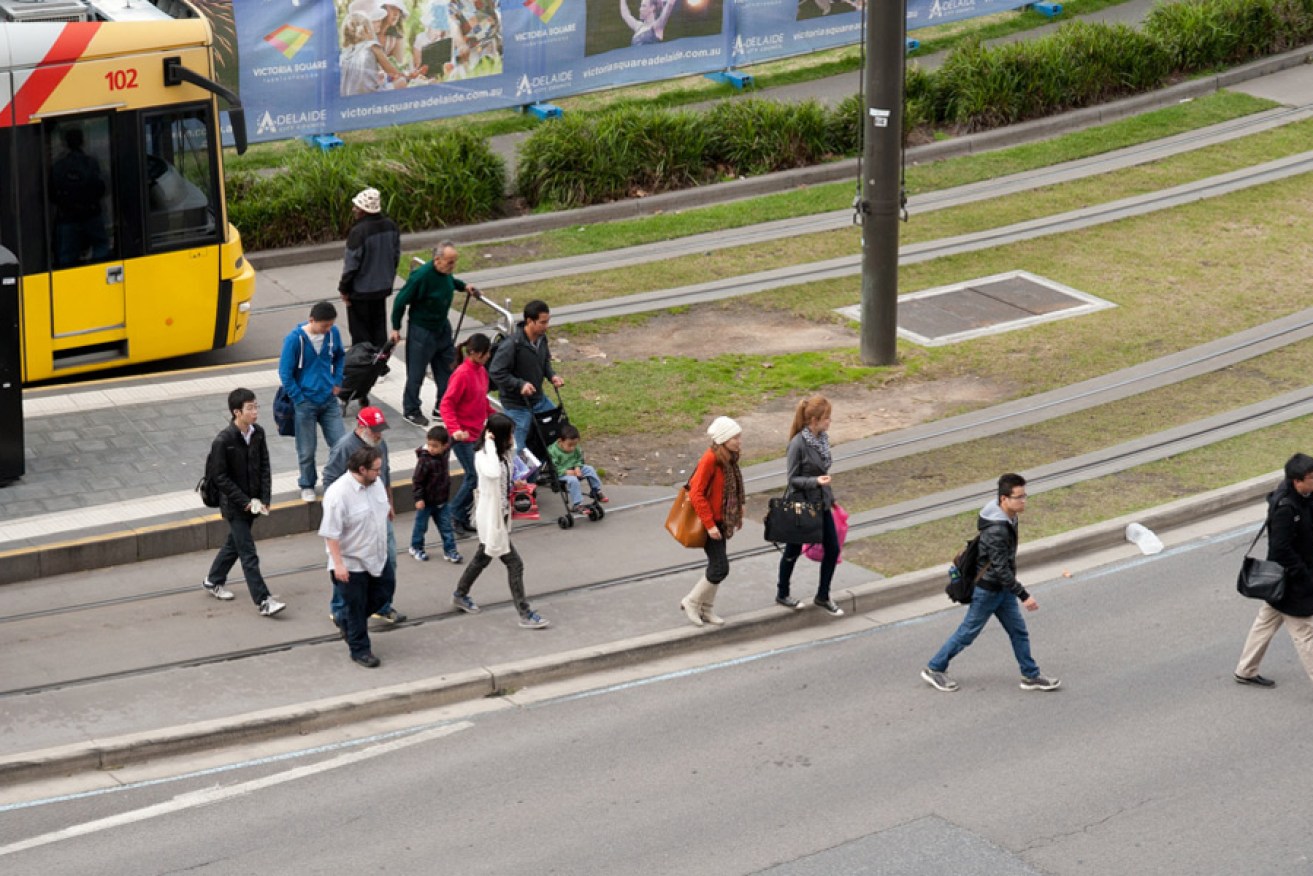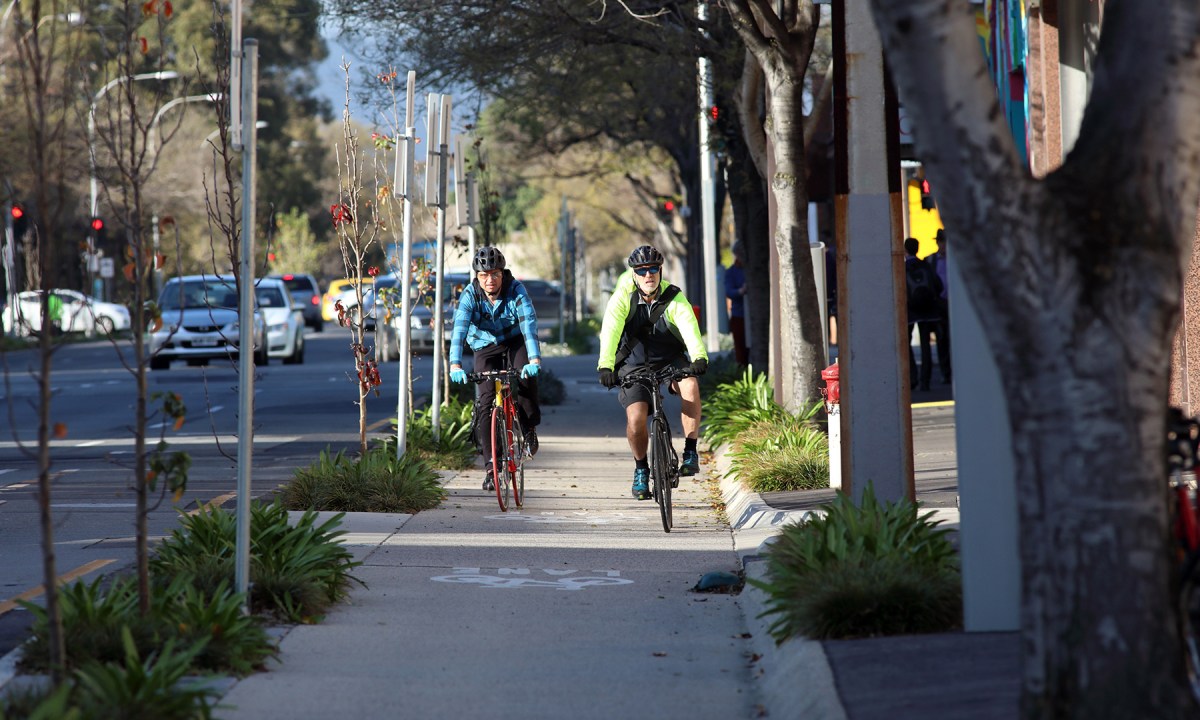SA Govt promises to prioritise cycling and walking in “low emissions” transport revamp
Walking and cycling infrastructure will be prioritised in road upgrades, while tram, train and bus services will become more efficient, accessible and frequent under a State Government plan to deliver a new “modern, low emissions” transport system to combat climate change.

Photo: Nat Rogers / InDaily
The Government has also promised to transition its entire public transport fleet to low and zero emissions vehicles powered by hydrogen and electronic technologies, in recognition that transport has become the largest direct source of greenhouse gas emissions in South Australia.
The transport reforms form part of 68 proposals in the State Government’s new Climate Change Action Plan, released today, which Environment Minister David Speirs branded “the most powerful vision for climate action of any South Australian Government in history”.
The plan outlines how South Australia would reach its targets to reduce greenhouse gas emissions by at least 50 per cent by 2030 and achieve net zero emissions by 2050.
According to the plan, which was developed with input from climate change economist Professor Ross Garnaut, achieving those goals requires “much more work from governments, business, communities and individuals, across all economic sectors”.
“Only a modest reduction in emissions is projected if no further action is taken,” the plan states.
“Transport was the largest direct source of emissions for South Australia in the 2018 financial year, contributing 29 per cent of total emissions.
“A modern, low emissions transport system will improve productivity, reduce congestion and improve air quality as well as reduce greenhouse gas emissions.”
The Government has promised to deliver a “customer-focused” public transport network to increase patronage and reduce private car use.
According to the plan, the Government would investigate more on-demand transport services, such as the services currently available in Gawler and on trial in Mount Barker and the Barossa Valley.
We have moved away from the outdated idea that addressing climate change is only achievable by the ‘left’ side of politics
It states the Government would also investigate converting its remaining diesel-powered suburban train lines to alternative power sources, following the completion of the Gawler rail electrification project.
The remainder of the state’s public transport fleet would be transitioned to “low and zero emissions vehicles”, which would be informed by “investigations and trials of viable hydrogen and/or electronic technologies, and other low emissions mass transit options”.
Already 53 per cent of the government’s fleet of 6750 passenger and light commercial vehicles are classified as either low or zero greenhouse gas-emitting.
“Emissions reduction will be supported in contracts for procurement, operation, maintenance and service delivery of the public transport fleet,” the plan states.
“To encourage South Australians to leave their cars at home and use the public transport network, the government will make tram, train and bus services more efficient, more accessible and more frequent.”
Meanwhile, cycling and walking infrastructure would be prioritised to encourage more active forms of travel.
“In road network allocation, increased priority will be given to pedestrians, separated bikeways and public transport,” the plan states.
“Priority greenways will be completed and the bikeways network will be expanded and separated as funding is made available.
“In addition, provision for pedestrians, cyclists and public transport in road network planning and upgrades will be increased.”
It comes after the Government pledged billions of dollars in its state budget on various road upgrades, including an estimated $8.9 billion on the new north-south corridor, $250 million over four years on a South Eastern Freeway and $185 million of Main South Road and Victor Harbor Road.
But no new funding was provided to cycling or pedestrian infrastructure.
The Adelaide City Council last night decided to yet again stall progress on the $5 million State Government and council-funded east-west bikeway, which has been in the works since 2016 and is now at risk of not meeting its funding deed deadline.

Photo: Tony Lewis / InDaily
Other actions outlined in the government plan include developing a “world class renewable hydrogen industry” and increasing interstate and international exports of renewable energy.
According to the plan, South Australia has the wind and solar reserves, as well as the infrastructure and skills, to become a “world-class renewable hydrogen supplier”.
“By 2050, it has been estimated that an Australian hydrogen industry could contribute $11 billion and 7600 jobs to the national economy,” the plan states.
“Many of these jobs could be located in regional areas in South Australia, especially around ports and existing industrial clusters where future hydrogen development is most likely to occur.”
If South Australia reaches its target of achieving net zero carbon emissions by 2050, it would produce a level of renewable energy that is more than 500 per cent of current local grid demand.
Renewables, including rooftop solar and wind, contributed to 57 per cent of the state’s electricity last financial year, with 2019-21 wholesale prices now lower in South Australia than in Victoria or New South Wales.
The price discrepancy between South Australia and the eastern states is set to grow as Victoria and New South Wales face the short-term effects of coal generation closures – an adjustment which has already been completed here.
Since the mid-2000s, South Australia has installed over 2000 MW of wind capacity, 400 MW of utility-scale solar and 1000 MW of distributed solar, allowing the state to transition away from being a large net importer of power to a net exporter over the past three years.
The State Government has also fast-tracked plans to build a new interconnector between South Australia and New South Wales to increase energy exports.
Addressing climate change is beyond esoteric slogans and activist campaigns
It has also pledged to deepen trade relationships and develop a “world-class regulatory framework”.
“This plan will lead us to be a stronger, more resilient export economy – both domestically by exporting power through interconnectors to NSW and Victoria and internationally as an exporter of clean hydrogen and other low emissions products,” Speirs said.
“Demand for low emissions and climate smart products is growing, and South Australia is well equipped to use our abundance of sun, wind and other natural resources to take full advantage of this growing demand.”
The Government has also pledged to “accelerate work towards net zero emissions in government” by securing a new electricity supply contract for the construction of a 280 mega-watt solar farm at Cultana near Whyalla and a 100 mega-watt battery near Port Augusta.
“The government will also invest in energy efficiency in government buildings and a transition of the government fleet to electric vehicles,” the plan states.
“This will reduce emissions, create jobs and deliver savings to taxpayers.”
In a report written by Garnaut and released by the Government in September, the climate change economist claimed that South Australia is “better equipped to respond to the challenges and opportunities of climate change than any other Australian state and nearly all the world’s sub-national jurisdictions”.
However, it is also becoming increasingly vulnerable to the effects of climate change, with the Government’s plan pointing out that average temperatures across the state are projected to rise by as much as 2.1 degrees Celsius by 2050.
“It is important to acknowledge that we have moved away from the outdated idea that addressing climate change is only achievable by the ‘left’ side of politics,” Speirs wrote in the plan’s forward address.
“Addressing climate change is beyond esoteric slogans and activist campaigns.
“It takes government leadership with the capacity to deliver real action through an intentional focus on tangible outcomes and a commitment to engaging with businesses and the market.”




